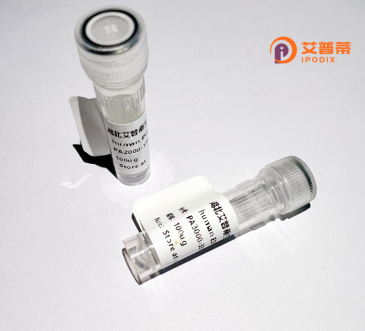
| 纯度 | >90%SDS-PAGE. |
| 种属 | Human |
| 靶点 | PTENP1 |
| Uniprot No | 0 |
| 内毒素 | < 0.01EU/μg |
| 表达宿主 | E.coli |
| 表达区间 | 1-369 aa |
| 活性数据 | MGFPAERLEGVYRNNIDDVVRFLDSKHKNHYKIHNLCAERHYDTAKSNYRVAQYPFEDHNPPQLELIKPFCEDLDQWLSEDDNHVAAIHCKAGKGRTGIMIYAYLLHRGKFLKAQEALDFYGEVRTRDKKGVTIPSQRRYVYYYSYLVKNHVDYRPVALLFHKMMFETIPMFSGGTCNPQFVVCQLKVKMYSSNSGPTRWEDKFMYFEFPQPLPVCGGIKVEFFHKQNKMLKKDKMFHFWVNTFFIPGPEETSEKVENGSLCDQEIDSICSIERADNDKEYLVLTLTKNDLDKANKDKANRYFSPNFKVKLYFTKTVEEPSNPEASSSTSVTPDVSDNEPDHYRYSDTTDSDPENEPFDEDQHTQITKV |
| 分子量 | 69.5 kDa |
| 蛋白标签 | GST-tag at N-terminal |
| 缓冲液 | PBS, pH7.4, containing 0.01% SKL, 1mM DTT, 5% Trehalose and Proclin300. |
| 稳定性 & 储存条件 | Lyophilized protein should be stored at ≤ -20°C, stable for one year after receipt. Reconstituted protein solution can be stored at 2-8°C for 2-7 days. Aliquots of reconstituted samples are stable at ≤ -20°C for 3 months. |
| 复溶 | Always centrifuge tubes before opening.Do not mix by vortex or pipetting. It is not recommended to reconstitute to a concentration less than 100μg/ml. Dissolve the lyophilized protein in distilled water. Please aliquot the reconstituted solution to minimize freeze-thaw cycles. |
以下是关于PTENP1的三篇参考文献,主要聚焦其作为假基因的非编码RNA功能及调控机制。由于目前研究多集中于PTENP1的RNA调控作用而非蛋白质表达,文献摘要以RNA相关机制为主:
---
1. **文献名称**:*A coding-independent function of gene and pseudogene mRNAs regulates tumour biology*
**作者**:Poliseno, L. et al.
**摘要**:该研究首次提出PTENP1作为PTEN的假基因,其转录的mRNA通过竞争结合microRNA(如miR-19b)来稳定PTEN mRNA,抑制肿瘤发展,揭示了RNA介导的ceRNA(竞争性内源RNA)机制。
2. **文献名称**:*The PTENP1 pseudogene functions as a competing endogenous RNA to promote PTEN expression by inhibiting miR-19b activity*
**作者**:Song, M.S. et al.
**摘要**:研究发现PTENP1通过吸附miR-19b,解除其对PTEN的抑制,从而上调PTEN蛋白水平,抑制肿瘤细胞增殖,并证实PTENP1的3'UTR区域在此过程中起关键作用。
3. **文献名称**:*Oncogenic signaling pathways in the cancer genome atlas: Pseudogene PTENP1 regulates cancer progression*
**作者**:Wang, G. et al.
**摘要**:通过分析癌症基因组数据,揭示PTENP1在多种癌症中低表达,其缺失导致PTEN信号通路失调,促进肿瘤侵袭转移,体外实验显示过表达PTENP1 RNA可抑制癌细胞恶性表型。
---
**备注**:当前研究普遍认为PTENP1为**非编码RNA**,其功能通过RNA相互作用实现。若需重组“PTENP1蛋白”相关研究,可能需进一步确认实验体系或关注PTEN蛋白重组表达文献。
PTENP1 is a pseudogene of the well-characterized tumor suppressor gene PTEN, sharing a high degree of sequence homology with its parental gene. Located on chromosome 9. PTENP1 is transcribed into a non-coding RNA that plays critical regulatory roles in cellular processes, primarily through competing with PTEN for miRNA binding. This interaction stabilizes PTEN mRNA, thereby enhancing PTEN expression and reinforcing its tumor-suppressive functions, including apoptosis, cell cycle arrest, and metabolic regulation.
The recombinant human PTENP1 protein, engineered for research and therapeutic exploration, is typically produced in vitro using expression systems like E. coli or mammalian cell cultures. It retains functional domains homologous to PTEN, particularly the phosphatase domain, though it lacks catalytic activity due to evolutionary mutations. Studies utilize recombinant PTENP1 to investigate its role as a molecular sponge for oncogenic miRNAs (e.g., miR-17. miR-19. miR-21) and its capacity to modulate PTEN-dependent pathways, such as PI3K/AKT/mTOR signaling. This protein also serves as a tool to dissect crosstalk between pseudogenes and their parental genes in carcinogenesis. Emerging evidence highlights its potential as a therapeutic agent or biomarker in cancers with PTEN dysregulation, offering a novel angle for targeting miRNA networks or restoring tumor suppressor activity. Current research focuses on optimizing delivery mechanisms, such as nanoparticle carriers, to enhance its stability and bioavailability in preclinical models.
×